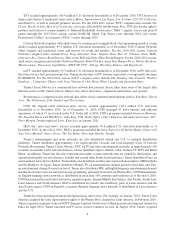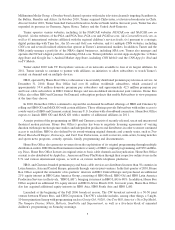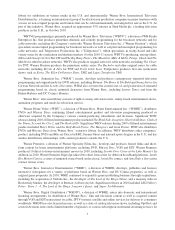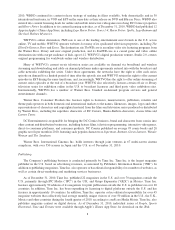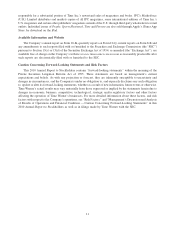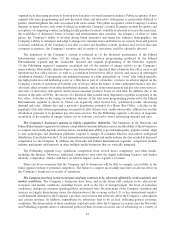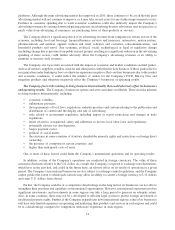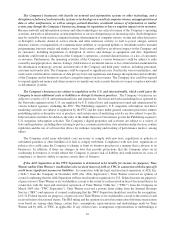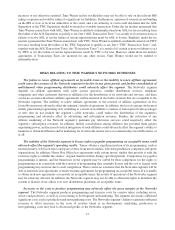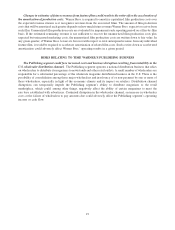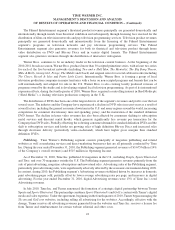Time Magazine 2010 Annual Report Download - page 24
Download and view the complete annual report
Please find page 24 of the 2010 Time Magazine annual report below. You can navigate through the pages in the report by either clicking on the pages listed below, or by using the keyword search tool below to find specific information within the annual report.RISK FACTORS
RISKS RELATING TO TIME WARNER GENERALLY
The Company must respond to recent and future changes in technology, services, standards and consumer
behavior to remain competitive and continue to increase its revenues. Technology, particularly digital technology
used in the entertainment and media industry, continues to evolve rapidly, and advances in that technology have led
to alternative methods for the distribution, storage and consumption of digital content. These technological changes
have driven and reinforced changes in consumer behavior as consumers increasingly seek control over when, where
and how they consume content digitally. For example, consumer electronic innovations have enabled consumers to
view Internet-delivered content, including films, television programming and magazines, on televisions,
computers, tablets, phones and other portable electronic devices. These changes in technology and consumer
behavior have resulted in a number of challenges and risks for content owners and aggregators, such as the
Company. For example, the growing number of content aggregators increases competition for programming and
consumers’ leisure and entertainment time and discretionary spending, and the increased availability of
programming online from content aggregators may diminish the perceived value of such programming in other
distribution windows and negatively affect consumers’ decisions to purchase such programming. The Company’s
failure to adapt to emerging technologies and changes in consumer behavior could have a significant adverse effect
on the Company’s competitive position and its businesses and results of operations.
Technological developments also pose other challenges for the Company that could adversely affect its
revenues and competitive position. For example, the Company may not have the right, or be able to secure the right,
to distribute content it licenses from others digitally or across new delivery platforms or devices that are developed.
Furthermore, advances in technology or changes in competitors’ product and service offerings may require the
Company to make additional research and development expenditures or offer products or services in a digital format
without charge or at a lower price than offered in other formats. New technology or business initiatives supported by
the Company may not be embraced by consumers or advertisers, and therefore may not develop into profitable
business models, which could have a significant adverse effect on the Company’s competitive position and its
businesses and results of operations. In addition, new delivery platforms could lead to the loss of distribution control
and the loss of direct relationships with consumers.
The Company faces risks relating to competition for the leisure and entertainment time and discretionary
spending of consumers, which has intensified in part due to advances in technology and changes in consumer
behavior. The Company’s businesses are subject to risks relating to increasing competition for the leisure and
entertainment time and discretionary spending of consumers. The Company’s businesses compete with each other
and all other sources of entertainment, news and other information, including broadcast television, films, the
Internet, home video products, interactive videogames, social networking, sports, print media, live events and radio
broadcasts, for consumers’ leisure and entertainment time and discretionary spending. Technological
advancements, such as tablets and other portable electronic devices, video-on-demand, new video formats and
Internet streaming and downloading, have increased the number of media and entertainment choices available to
consumers and intensified the challenges posed by audience fragmentation. The increasing number of leisure and
entertainment choices available to consumers, including low-cost or free choices, could negatively affect consumer
demand for the Company’s products and services, the prices content aggregators are willing to pay to license the
Company’s content and advertisers’ willingness to purchase advertising from the Company’s businesses, which
could reduce the Company’s revenues and could also result in the Company incurring additional marketing
expenses.
The popularity of the Company’s content is difficult to predict and could lead to fluctuations in the
Company’s revenues, and low public acceptance of the Company’s content may adversely affect its results of
operations. The production and distribution of television programming, films, interactive videogames, magazines
and other content are inherently risky businesses, largely because the revenues derived from the production,
distribution and licensing of such content depend primarily on its acceptance by the public, which is difficult to
predict. As more cable networks and premium pay television services produce and acquire more original
programming, the Networks segment faces increasing pressure to produce and acquire more new compelling
programming. With the scheduled theatrical release of the final Harry Potter film in 2011, the Filmed Entertainment
12




